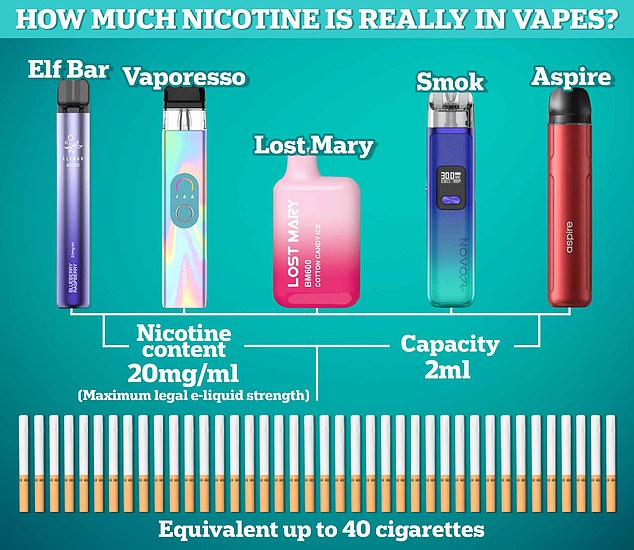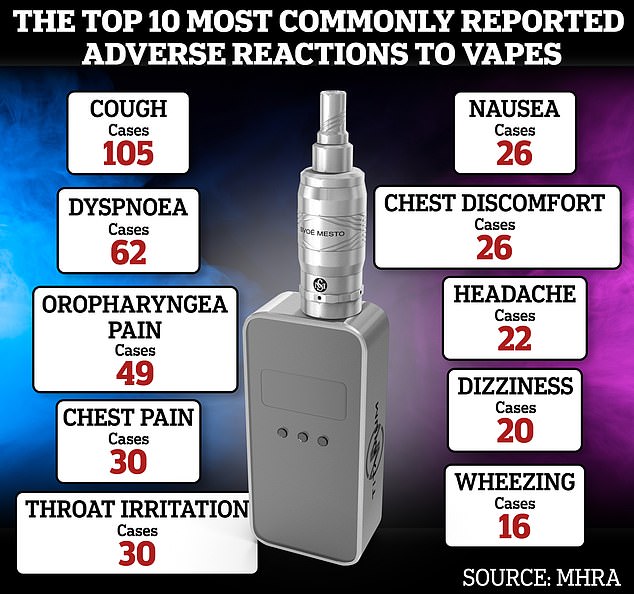World Health Organization’s war on vapes continues as body-regulating devices cannot be recommended to help people quit smoking, contrary to NHS advice
Vapes cannot be recommended as a way to quit smoking because too little is known about their benefits and harms, according to World Health Organisation (WHO) bosses.
The international organisation’s ruling contradicts advice from the NHS, which says the devices are an effective way to kick the habit, which is one of the biggest causes of illness and death in the UK.
In a globally unique guideline outlining possible interventions to help people quit using tobacco products, the WHO describes the evidence surrounding e-cigarettes as ‘complex’.
Vapes “may” be recommended as a smoking cessation aid in the future “as evidence accumulates,” the report said.
Instead, health officials should support “behavioral” supports, such as counseling, smartphone apps and nicotine replacement therapy, to help people quit smoking.
Currently, the NHS recommends the devices as a healthier way to kick the habit, which is one of the biggest causes of illness and death in the UK. Yet the UN agency called e-cigarettes “complex” in a world-first guideline outlining interventions to help people quit.
The recently published WHO document states: ‘E-cigarettes are outside the scope of this guideline because the potential benefits and harms of using these products are complex and are addressed in a separate literature.
“These products may be addressed in the future as more evidence becomes available.”
However, according to the NHS, e-cigarettes are much less harmful and can help people quit smoking for good.
Responding to the press release, Dr. Rüdiger Krech, Director of Health Promotion at WHO, added: ‘The immense struggle people face when trying to quit smoking cannot be overstated.
“We must fully realize how much strength it takes and how much suffering people and their loved ones have to endure to overcome this addiction.
‘These guidelines are intended to help communities and governments provide the best possible support and assistance to those making this challenging journey.’
This latest ruling is just the latest in a series of rulings and statements against vapes by the WHO
Last year, the UN agency called for a ban on all flavored e-cigarettes worldwide and treating them the same as cigarettes.
The WHO said at the time that “urgent measures” were needed to control their sales and warned that the devices could fuel nicotine addiction in non-smokers.
Earlier this year, the company was also criticized by fact-checkers for claiming that vaping can cause a seizure within 24 hours.
E-cigarettes allow people to inhale nicotine in the form of vapor. This vapor is created by heating a liquid, which typically contains propylene glycol, glycerin, flavorings, and other chemicals.
Unlike traditional cigarettes, they do not contain tobacco and do not produce tar or carbon – two of the most dangerous elements.
The effect of nicotine on the brain is well known: within 20 seconds of inhalation, it causes the release of chemical messengers such as dopamine, which are associated with reward and pleasure.
But it also increases heart rate and blood pressure and causes blood vessels to constrict. This is because nicotine triggers the release of the hormone adrenaline.

Campaigners have long blamed predatory manufacturers for the growing crisis, claiming they deliberately lure children in with colourful packaging, rather than highlighters, and child-friendly flavours such as bubble gum and candy floss.

In February, a total of 1,009 reactions to vapes were recorded by the Medicines and Healthcare products Regulatory Agency. Here are the 10 most common reports
Despite NHS chiefs insisting it is safer than smoking, vaping is not without risk. E-cigarettes contain harmful toxins and their long-term effects remain a mystery.
Experts fear that the high nicotine content could raise blood pressure and cause other heart problems.
Doctors fear that in the coming decades there could be a wave of lung diseases, dental problems and even cancer in people who start smoking at a young age.
In April, a shocking study warned that e-cigarettes could increase the risk of heart failure.
Another suggestion is that vaping causes cell changes that could lead to cancer.
Earlier this year, MailOnline also found that the number of vaping side effects reported to UK regulators has now passed 1,000, with five of them being fatal.
The comprehensive list covers everything from headaches to strokes and is open to members of the public and medical professionals.
Nicotine-laden gadgets have also become increasingly popular among young people.

A shocking MailOnline investigation last year even revealed vapes that looked like sweets, with high street shops selling the devices alongside chocolate and fruit gummies
Figures show that the number of children using e-cigarettes has exploded as traditional smoking declines. More than a third of 16-18 year olds now regularly inhale e-cigarettes.
For comparison, ten years ago, less than one in ten did so.
This is despite the fact that the sale of e-cigarettes to under-18s is illegal, with anyone caught selling them to children risking a fine and prosecution by Trading Standards.
Campaigners have long blamed predatory manufacturers for the growing crisis, claiming they deliberately lure children in with colorful packaging instead of highlighters, and kid-friendly flavors like bubble gum and candy floss.
In a bid to stamp out the epidemic of child vaping in the UK, Rishi Sunak last year pledged to ban disposable e-cigarettes altogether.
Such devices, which are popular with children, were expected to be banned in early 2025.
The prime minister wants to take stricter measures and expects vapes to be limited to four flavours, sold in plain, tobacco-like packaging and displayed out of sight of children.
But the July general election has dashed any hopes of the historic bill being passed by this parliament.
Both Germany and Ireland have presented their own proposals to impose restrictions on e-cigarettes, while Berlin authorities are currently considering a complete ban on disposable e-cigarettes.
In addition, Australia has taken measures to make vapes available only to those with a doctor’s prescription.
Meanwhile, New Zealand has also imposed restrictions that ban vape shops from being within 300 metres of a school and require all vapes to have removable batteries.
While the potential long-term dangers of vaping are not yet established, there is ample evidence that smoking is harmful to health.
An estimated 76,000 people die each year in the UK from smoking-related health problems, including heart disease, stroke and cancer.

